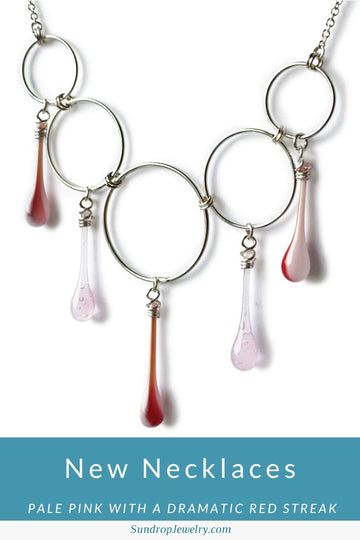
What is a pair of sundrops made of ?
Well, a scientific scale and some quick calculations tell me that a pair of sundrop earrings weighs about 3.6 grams. Of that, 22% is glass (the sundrops), 15% is silver (wire wrapping and ear hooks), 4% is plastic (ear nuts), and 59% is paper (display cards). I never realized it was quite that much paper! But I'll have to get back to that later. Today, I'm going to talk a bit about glass.22% glass, 15% silver,
4% plastic, 59% paper We work mostly with colored sheet glass we buy from the Bullseye Glass Company, via Seattle Stained Glass. We also use recycled bottle glass for some colors.
Where does glass come from?
The main ingredient in glass is sand, which usually makes up two thirds to three quarters of its weight. Sand, obviously, can come from just about anywhere, but not all sand is suitable for making glass. To make clear transparent glass, you need especially pure silica sand - sand that's mostly quartz. This sand is generally mined from sandstone quarries, mostly in the midwest (home of the St. Peter sandstone). Apparently, the U.S. has quite a lot of this sort of sand, and we're the world's largest producer and consumer of industrial sand and gravel. I'm not sure what the environmental impacts of sand mining are - stay tuned for a later episode.

Stained glass starting materials and
bottle glass starting materials. The beauty of our government bureaucracy is that it gives all industries a fancy designation and code (the North American Industry Classification number for "flat glass manufacturing" is 327211), and then tracks all sorts of things about them.
The Energy Information Administration (part of the Department of Energy), does this pretty cool thing called the "Manufacturing Energy Consumption Survey", where they compare the energy usage of different industries.
Looking here, I can find that flat glass uses 63 trillion Btus of energy per year (or 18 billion kilowatt hours), which is about 0.3% of the total manufacturing energy usage in the country. By itself, that doesn't tell me a whole lot. So I decided to compare it to some other industries. The least energy intensive industry on the list is "leather goods" at only 7 trillion Btus. The most energy intensive is "petroleum refineries" at about 6,400 trillion Btus. But this isn't really a fair comparison. After all, we use a whole lot more petroleum than leather.
Luckily, they also have done a comparison that looks at energy usage per dollar value of the final product. Basically, this lets you compare industries without worrying about their relative size.
Flat glass uses 22.5 thousand Btus of energy per dollar of glass produced.

energy use - selected industries
How does this compare to other industries?
The best performers here, interestingly, are "computer and electronic products" and "tobacco", both of which come out at 0.5 thousand Btus of energy per dollar of product. Both of these industries make relatively small and expensive things. If you sell a computer for $2,000, it doesn't take much energy to make each dollar - most of the costs will reflect things like labor.The worst performers here are fertilizers. "Lime" (used for fertilizer, cement, and other things) comes in at a whopping 102 thousand Btus per dollar, and "Nitrogenous fertilizers" at 59 thousand Btus per dollar. Which makes me think that when oil starts running out, one of the big things we're going to need to worry about is our food supply.

energy use per dollar -
selected industries Glass is actually pretty high up on this list - number 17 of about 70 industries. Since the raw materials of glass are pretty cheap (sand), and there's not a lot of labor involved in the process of making it, most of what goes into a sheet of glass is a whole lot of heat. Glass is heated up to between 2,300 and 2,800 degrees Fahrenheit in the manufacturing process, a couple hundred degrees of which can be saved by using recycled glass (re-melting glass takes slightly less energy than the initial reaction with raw ingredients). Here are a couple links describing the window glass manufacturing process and the container glass manufacturing process
Carbon footprint of glass making
The carbon footprint of an industry comes from both its energy usage, and where it gets that energy. Glass manufacturing uses mostly natural gas furnaces (83%) for its heat, which makes it relatively carbon intensive.Another interesting page from the Energy Information Administration tells us the carbon emissions and "carbon intensity" for different industries. This one's a bit out of date (1994), but still interesting. Glass is part of the "stone, clay, and glass" sector, which emits about 6% of the total carbon emissions from manufacturing.

Energy use and carbon footprint of glass manufacturing
But if you break that up into its component parts, you'll find that most of those emissions come from cement. The flat glass industry puts about 1 million metric tons of CO2 into the air in 1994, out of a total of 372 million metric tons from all U.S. manufacturing industries.
Of course, all this interesting stuff is general to the whole U.S., and mostly reflects big manufacturers of window glass, rather than small manufacturers of art glass. In my next post (or whenever they end up replying to me), I'll try to follow the raw materials and energy use of a sheet of Bullseye Glass specifically.
And because I'm totally shocked to find out that paper is over half the weight of a pair of earrings, I'm planning to start in on the impact of the paper in our display cards.
Related Articles





